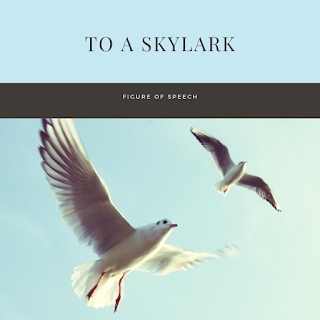Figure of Speech in “To a Skylark”
In “To a Skylark”, Shelley
uses a number of poetic devices with a view to bringing his idea home. The poem
opens with the trope figure of speech called an apostrophe in which an object
or a nonhuman entity—in this case, the skylark – is spoken to as thought it
were a living human: “Hail to thee, blithe Spirit!” Personification occurs when
the poet addresses the bird as if it were a human being. There follows in the
fourth line of the opening stanza a synecdoche in “thy full heart”, wherein a
physical object-
“heart” is used to represent the whole, the skylark. A metonymy occurs in the fourth line of the second stanza: “The blue deep thou wingest”. The “blue deep” is a suggestive specific object that represents a larger whole or general concept: In this case the metonymy of “blue deep” is standing for the Earth’s physical atmosphere or sky. There are metaphors in the poem with the skylark being Shelley’s natural metaphor for poetic inspiration and expression. Shelley uses metaphors to describe the days light such as “arrows of the sun”. There are alliterations line expressions like “pale purple even”, “of that silver sphere” or “Till the world is wrought”. The poem also abounds in Shelley’s use of similes to capture the joy and beauty of the bird and its song. There are similes in expression like “like a cloud of fire”, “like an unbodied joy”, “Like a glow-worm golden” or “Like a rose embower’d”.
“heart” is used to represent the whole, the skylark. A metonymy occurs in the fourth line of the second stanza: “The blue deep thou wingest”. The “blue deep” is a suggestive specific object that represents a larger whole or general concept: In this case the metonymy of “blue deep” is standing for the Earth’s physical atmosphere or sky. There are metaphors in the poem with the skylark being Shelley’s natural metaphor for poetic inspiration and expression. Shelley uses metaphors to describe the days light such as “arrows of the sun”. There are alliterations line expressions like “pale purple even”, “of that silver sphere” or “Till the world is wrought”. The poem also abounds in Shelley’s use of similes to capture the joy and beauty of the bird and its song. There are similes in expression like “like a cloud of fire”, “like an unbodied joy”, “Like a glow-worm golden” or “Like a rose embower’d”.

